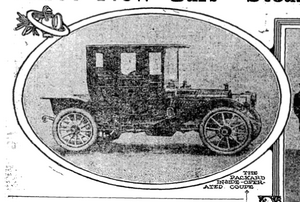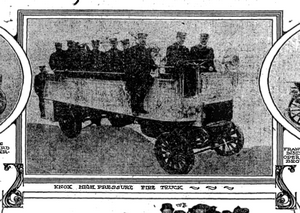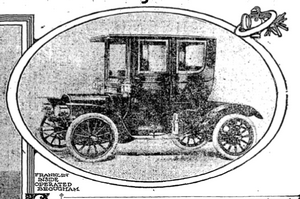
















|
|---|
|
Packard and Franklin Exhibit Attractive Inside-Driven Cars—The Knox Fire Truck. Publication: The New York Times Date: 31 January 1909 Topics: Packard, Franklin, Knox 
|
 THE PACKARD INSIDE-OPERATED COUPE THE PACKARD INSIDE-OPERATED COUPE
 KNOX HIGH PRESSURE FIRE TRUCK KNOX HIGH PRESSURE FIRE TRUCK
 FRANKLIN INSIDE OPERATED BROUGHAM FRANKLIN INSIDE OPERATED BROUGHAM
|
Two inclosed cars driven from the inside are pictured above. One is the Packard inside-driven coupé, and the other the Franklin inside-driven brougham. The newest Packard car is an adaptation of the standard Packard “30” runabout.
The Packard company has been responsible for many innovations in respect to body building, but it has never departed from its regular mechanical practice. In the case of its newest car the foundation is the standard Packard chassis construction. The new body is interchangeable with the regular Packard runabout without alteration of the levers or mechanical parts. The owner of a Packard runabout may use it as an open car in the Summer, and in Fall or Winter may exchange the body for the new coupé type.
The inside-operated coupé is especially designed for doctors, business men, and others who wish to drive continuously during the Winter. The body is built in the limousine department of the Packard shops, and has all the features and excellence of construction of the Packard limousine and landaulet models.
The Franklin offering for 1909 is of 18 horse power, built upon the same chassis as the touring car of similar horse power. It is an adaptation of the doctor's closed carriage and is designed for those want to do their own driving while at the same time enjoying the comfort of a limousine or a landaulet. The doors are wide and provide easy entrance for the two people which the car is designed to carry. The finish is in Franklin standard colors and the trimming of the interior of goat skin with blue broad lace.
There is an extension over the front of the car affording protection when the front window is slightly lowered and in addition protecting the glass in heavy storms. An ample chassis provides room at the rear for a good-sized receptacle.
The first test of an automobile fire wagon designed for use in connection with the new high pressure service of New York's Fire Department, was made just a week ago to-day at noon, in the presence of Commissioner Whitney, Fire Chief Croker, Capt. Rush, and Battalion Chief Archer at Station 78 at the foot of Gansevoort Street.
The automobile fire wagon was driven from Madison Square Garden, where the ninth annual exhibition of the association of licensed automobile manufacturers had just closed, at midnight Saturday, to the general shops of the Fire Department at Fifty-eighth Street and Twelfth Avenue for official inspection, and from there it was driven to the testing place with its equipment and twenty men on board.
On its route down through the city, the way being via Broadway and Fifth Avenue to Twelfth Street, the auto fire wagon showed a speed of 26 miles an hour on the speedometer and took corners at the rate of 12 and 15 miles an hour. It was found that the big car did not skid because of the double solid rubber tires on the rear wheels. Chief Croker followed the piece of apparatus all the way downtown in his six-cylinder car to observe its conduct in the press of city traffic.
Arrived at the testing place, the fireboat Thomas Willett supplied pressure through two leads of hose. Pressure up to 300 pounds was maintained without difficulty, the swivel nozzle on the car, like those on the fireboat, throwing a stream a distance of 125 feet at all angles.
After the test the car was driven to Station 72, in East Twelfth Street, for which it was ordered. The car was built to order by the Knox Automobile Company and weighs five tons. It is guaranteed to carry a load of five tons and to do 30 miles an hour through city streets.
